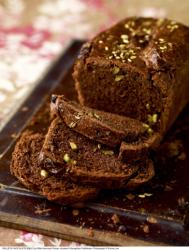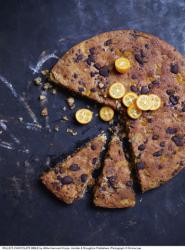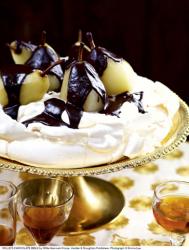 Cacao and Olive Bread
Cacao and Olive Bread
Makes 1 large loaf or 10 rolls
Ingredients:
300g plain white flour
100g strong wholemeal flour
1 teaspoon salt
1 ½ teaspoon easy-blend yeast
150ml full fat milk
150ml water
75g Venezuelan Carenero Superior 100% cacao, chopped or grated
75ml extra virgin olive oil
200g green olives, pitted and chopped
1 egg yolk, beaten or 1tbsp milk
1 tbsp fennel seeds
Method:
- Sift the flours and salt into a large mixing bowl and stir in the yeast. Warm the milk and water in a saucepan. Add the cacao and stir until it has melted. Pour in the olive oil and mix well. Tip this warm liquid into the bowl of dry ingredients and mix thoroughly to form a soft, but not sticky, dough. Add more flour or warm water if necessary to achieve the right consistency. Turn out onto a lightly floured surface and knead for ten minutes, until soft and elastic. You can also make the dough in a food processor or an electric mixer with a dough hook attachment. Simply place the flour, salt and yeast in the mixer or processor bowl, then add a warm liquid and process for about 5 minutes.
- Sprinkle the chopped olives over the dough and knead a little more to mix in. Place in a lightly greased bowl. Cover with a clean tea towel, or place another large bowl upturned on top. Leave in a warm place for at least two hours to allow the dough to rise, doubling in size.
- Tip the risen dough onto a floured surface and knock it back to its original size. Press into a large, oiled bread tin or divide into ten pieces and shape each into a small roll. Place the rolls on an oiled baking tray. Lightly brush the top of the loaf or the rolls with either a little egg yolk or milk, then sprinkle over the fennel seeds. Leave in a warm place for about 1 hour, or until well risen (almost doubled in size).
- Preheat the oven to 190 degrees Celsius and bake the bread: 45 minutes for the loaf, or 15 minutes for the rolls. To test if the bread is done, tap it sharply on the underside – it should sound hollow. If not, return to the oven for a further 3-5 minutes and test again. When fully cooked, turn the loaf out of the tin, or remove the rolls from the tray, and leave to cool on a wire rack.
 Orange, Almond, Ginger and Bitter Chocolate Cake
Orange, Almond, Ginger and Bitter Chocolate Cake
Serves 8-10
Ingredients:
200g slightly salted butter, softened
200g caster sugar
250g ground almonds
1 tsp vanilla essence
3 eggs
Grated zest of 3 oranges
Juice of ½ orange
75g medium-ground polenta
½ tsp baking powder
½ tsp cream of tartar
50g candied orange peel, roughly chopped
60g ginger, preserved in syrup, roughly chopped
80g Venezuelan Hacienda Las Trincheras 100% cacao, roughly chopped
For the syrup:
Juice of 2 oranges
2½ tbsp ginger syrup (from the preserved ginger)
¼ vanilla pod
Equipment: 28-cm cake tin (preferably with sloping sides)
Method:
- Preheat the oven to 160°C. Lightly grease the cake tin and line with baking paper.
- Beat the butter and sugar together in a large bowl until light and fluffy. Blend in the ground almonds and vanilla essence, then beat in the eggs one at a time. Mix in the orange zest and juice, then fold in the polenta, baking powder and cream of tartar. Finally, mix in most of the candied peel, preserved ginger and cacao, keeping back a little of all three to decorate.
- Tip the mixture into the prepared tin, smooth the top and sprinkle over the pieces of reserved candied peel, preserved ginger and cacao. Bake in the preheated oven for 40 minutes, or until a skewer inserted into the centre of the cake comes out clean. Leave the cake to cool in the tin, then turn out onto a serving plate.
- Prepare the syrup by placing the orange juice, ginger syrup and vanilla pod in a saucepan over a medium heat. Bring to the boil, lower the heat and cook until reduced to about 65ml liquid. While still hot, brush the syrup all over the cake, using a pastry brush. Allow the syrup glaze to cool completely before serving. This cake will keep well for just over a week if kept in a cool place in an airtight container.
 Poached Pear Pavlova with a Bitter Chocolate Sauce
Poached Pear Pavlova with a Bitter Chocolate Sauce
Serves 6
Ingredients:
120g granulated sugar
1 litre water
1 vanilla pod, split lengthways
6 ripe but firm pears (Comice are good)
200g Peruvian San Martin 70% chocolate, roughly chopped
5 large egg whites
300g caster sugar
1 tsp cornflour
1 tsp vanilla essence
1 tsp lemon juice
300ml double cream
Equipment: Baking tray about 36cm square
Method:
- Heat the granulated sugar with the water in a large saucepan over a moderate heat, stirring until the sugar dissolves. Bring just to the boil, lower the heat and add the vanilla pod. Leave to simmer gently while you prepare the fruit.
- Peel the pears, leaving the stalks on. Stand them in the syrup, then cover and poach very gently for about 1 hour, until soft but still holding their shape. Using a slotted spoon, carefully lift out the pears and set aside to cool. Turn up the heat under the syrup in the pan and reduce to about 150ml. Remove from the heat and stir in the chocolate until melted, then beat until smooth and well blended. Set aside to cool.
- Preheat the oven to 140 degrees Celsius. Line the baking tray with baking paper.
- Make a meringue mixture by whisking the egg whites until they form stiff peaks. Add a quarter of the caster sugar and beat again until stiff. Continue adding the sugar in this way until it is all used and the mixture is stiff. Carefully fold in the cornflour, vanilla essence and lemon juice until well combined.
- Pile the meringue mixture onto the prepared baking tray, shaping it into a circular mound about 5cm from the edge of the tray: this gives it space to expand while cooking. Bake in the preheated oven for about 1 ¼ hours, or until the meringue is a very pale biscuit colour. Remove from the oven and set aside on a baking tray to cool completely.
- When cold, very carefully turn the meringue mixture over and peel off the baking paper. Turn it back over and place on a serving plate.
- Lightly whip the cream until just stiff and spread it over the meringue, leaving about a 3-cm margin around the edge. Place the poached pears on top of the cream. Transfer to the fridge to chill for at least an hour, preferably longer. Just before serving, pour over about half of the cooled chocolate sauce, offering the remainder in a jug on the side.
These recipes are taken from Willie’s Chocolate Bible, published by Hodder & Stoughton (£25) to accompany Qin Xie’s review here.
{ISBN:0340993561}

